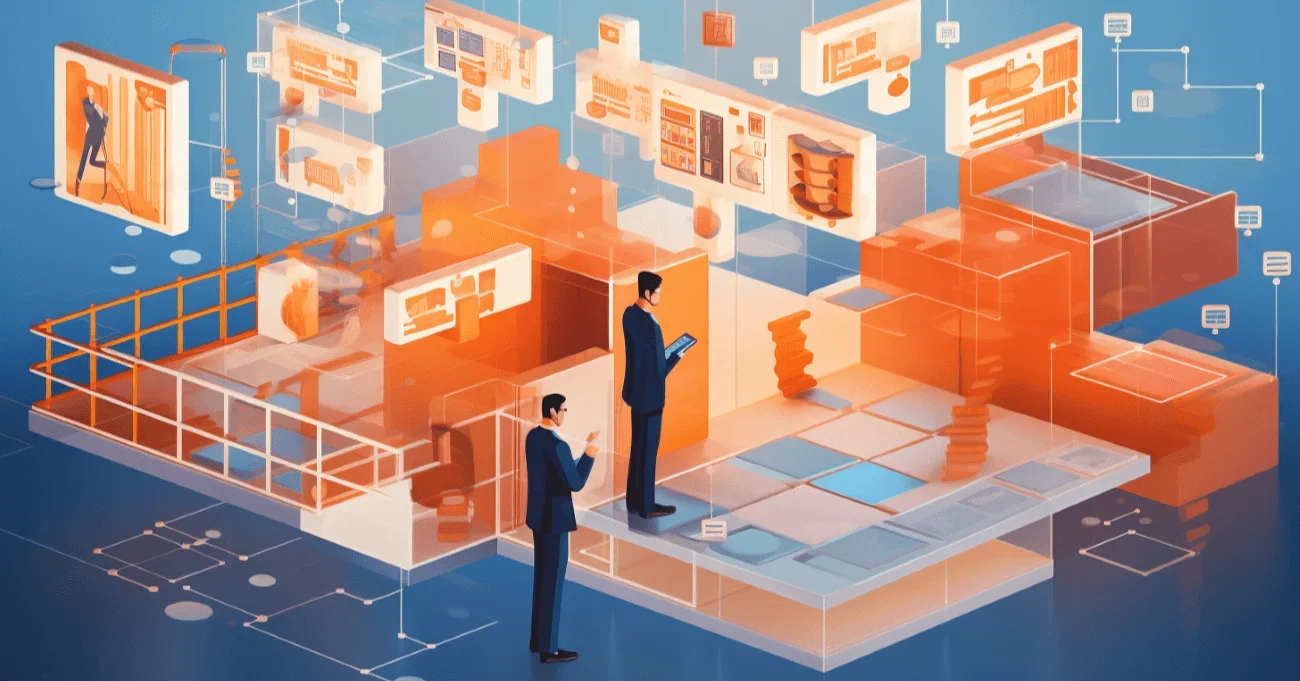Multi-tenant SaaS databases are a transformative concept in software development, offering startups and businesses the efficiency and scalability needed to thrive in today's competitive landscape. By sharing infrastructure and resources, SaaS applications allow numerous customers or tenants to access the same software instance, providing cost efficiency and customization options that were once out of reach.
At Aloa, we understand the challenges and opportunities of SaaS and multi-tenancy architecture. Our expertise in software development and application customization enables businesses to harness the benefits of this approach while ensuring data security, access control, and scalability.
This blog will delve into multi-tenant SaaS, from the building process to the core features of SaaS multi-tenant databases. We emphasize the importance of understanding your tenants' needs to ensure the success of your SaaS solution.
Afterward, you will clearly understand how to build a SaaS and multi-tenancy database, its advantages, and critical considerations. Whether in healthcare, finance, or any other industry, our insights will help you make informed decisions toward a SaaS and multi-tenancy application that caters to your customer's demands and elevates your business to new heights.
Let's dive in!
7 Steps to Build a Multi-tenant SaaS Database
Building a Multi-tenant SaaS Database is a transformative endeavor that can benefit businesses. This scalable and cost-effective approach to software development allows multiple tenants to share a common infrastructure, making it an ideal solution for startups and companies. Let's dive into building a successful SaaS and multi-tenancy solution.
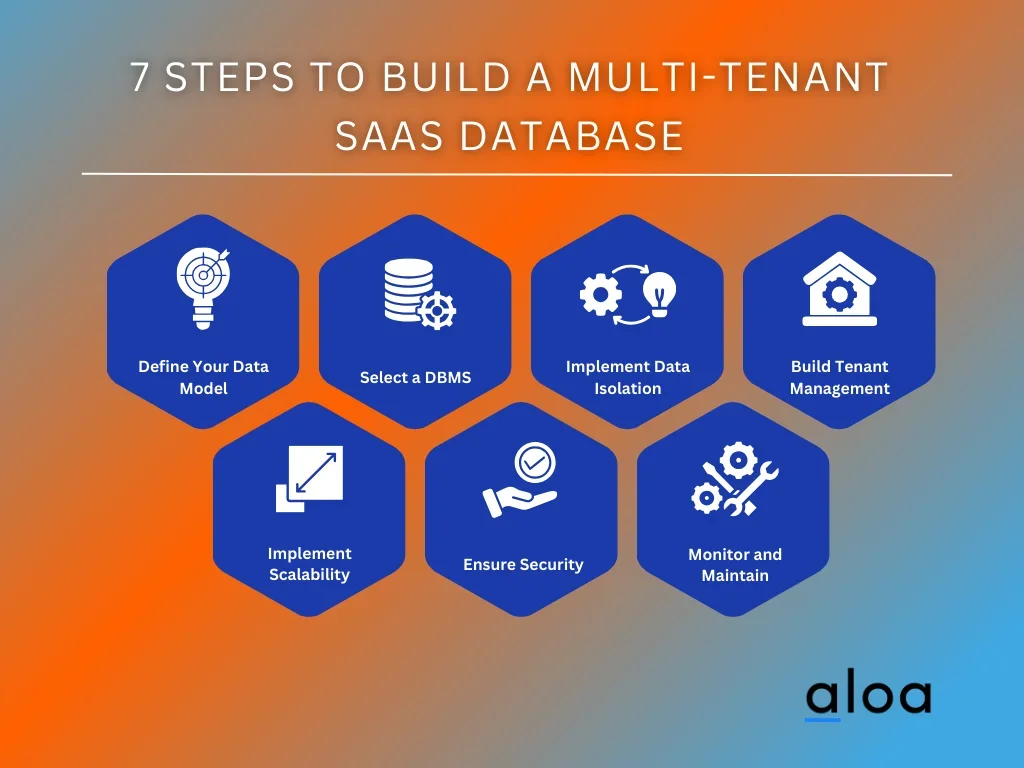
Step 1: Define Your Data Model
Defining your data model is the critical first step in constructing a SaaS and multi-tenancy database. It involves outlining what data your application will manage for each tenant and how this information will be structured, related, and accessed. A solid data model is the foundation for your entire system, ensuring data integrity, efficient retrieval, and scalability. Here's a more concise look at this pivotal step:
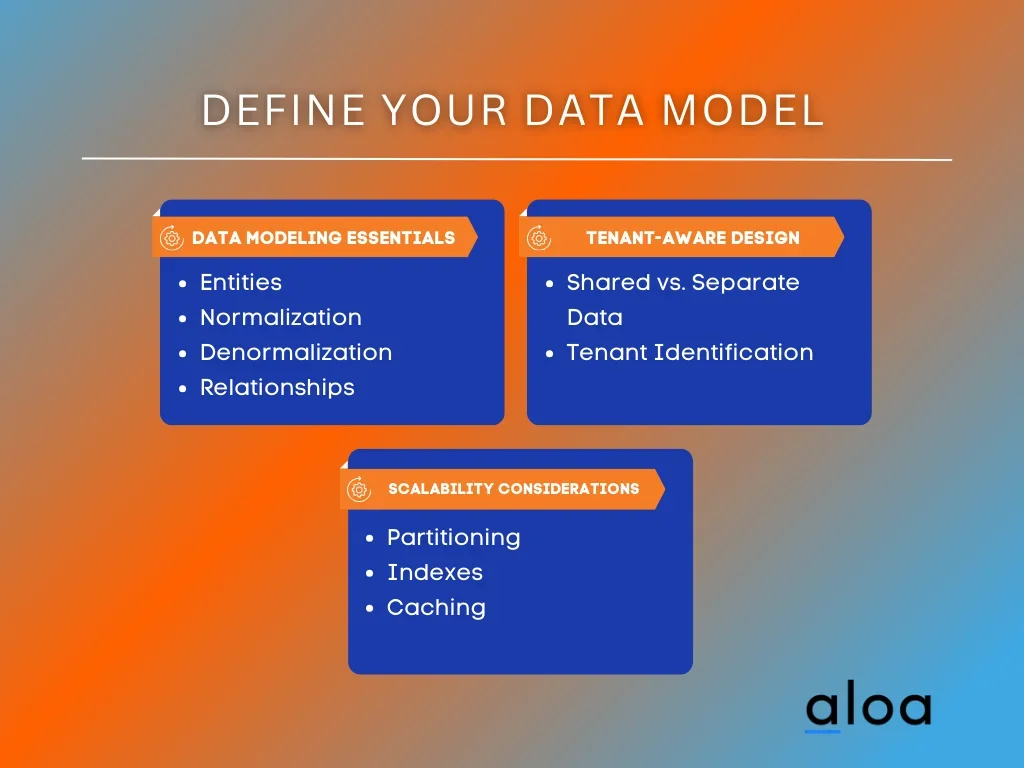
Data Modeling Essentials
- Entities: Identify core entities (customers, products, and orders) and specify their attributes, data types, constraints, and relationships.
- Normalization: Organize data efficiently by minimizing redundancy and adhering to normalization principles like 1NF, 2NF, and 3NF.
- Denormalization: When necessary for performance, reintroduce controlled redundancy through denormalization.
- Relationships: Establish connections between entities, enabling effective queries and data consistency.
Tenant-Aware Design
- Shared vs. Separate Data: Decide what data will be shared among tenants (e.g., global references) or kept separate (e.g., tenant-specific records).
- Tenant Identification: Implement a mechanism to distinguish tenant data, such as a "tenant ID" column or schema-per-tenant architecture.
Scalability Considerations
- Partitioning: Plan for horizontal partitioning to distribute tenant data across servers for scalability.
- Indexes: Carefully design and apply indexes for efficient data retrieval.
- Caching: Improve performance with caching mechanisms, reducing the database load.
Defining your data model forms the cornerstone of your SaaS and multi-tenancy database, influencing its overall efficiency and adaptability while accommodating tenants' unique needs. This blueprint sets the stage for subsequent steps like choosing the right database management system and ensuring data isolation and security.
Consider partnering with Aloa for your development needs. With a track record of excellence in software development, Aloa can be your trusted ally in building and maintaining a robust multi-tenant SaaS database. Their expertise ensures a seamless, scalable, and secure solution, helping your business thrive in the competitive SaaS landscape.
Step 2: Choose a Database Management System
Selecting the right Database Management System (DBMS) is pivotal in building a SaaS and multi-tenancy database. The choice of DBMS will significantly impact your system's performance, scalability, and security.
Several popular DBMS options are well-suited for multi-tenancy. MySQL, PostgreSQL, and NoSQL databases like MongoDB are often preferred choices. When making this decision, it's essential to consider several factors:

- Scalability: Ensure the chosen DBMS can scale horizontally to accommodate growing tenants and data. It should offer clustering or sharding capabilities to distribute the load efficiently.
- Security: Look for robust security features, including authentication mechanisms, role-based access control, and encryption options. Data isolation between tenants should be fundamental to the DBMS's security.
- Performance: Evaluate the DBMS's performance characteristics, such as query optimization and indexing, to ensure efficient data retrieval and processing.
- Community and Support: Consider the availability of a supportive community and access to professional support services for your chosen DBMS.
- Cost: Assess the total cost of ownership, including licensing fees, hardware requirements, and operational costs associated with the DBMS.
By carefully weighing these factors and aligning them with your specific project requirements, you can choose a DBMS that will serve as a solid foundation for your SaaS and multi-tenancy database, supporting its scalability and security needs as it evolves.
Step 3: Implement Data Isolation
Data isolation is a fundamental aspect of building a SaaS and multi-tenancy database. It's essential to guarantee the privacy and security of each tenant's data. There are several strategies to achieve data isolation.
One approach is to use a schema per tenant, where each tenant has a dedicated schema within the database. This ensures complete separation of data, preventing any accidental data leakage between tenants. Alternatively, row-level security can be employed, where data access is controlled at the row level based on tenant-specific permissions. This fine-grained control allows for more flexibility while maintaining data separation.
A hybrid approach, combining schema per tenant and row-level security elements to strike the right balance between security and scalability, may also be beneficial.
Regardless of the chosen method, strict measures should be in place to enforce data isolation, guaranteeing that tenants cannot access or view each other's data, thus preserving the integrity and confidentiality of the SaaS and multi-tenancy application.
Step 4: Build Tenant Management
A well-structured Tenant Management system is the backbone of a successful SaaS and multi-tenancy database. It serves as the gateway for tenant interaction and ensures smooth onboarding and ongoing engagement. Here are four important considerations when building this component:
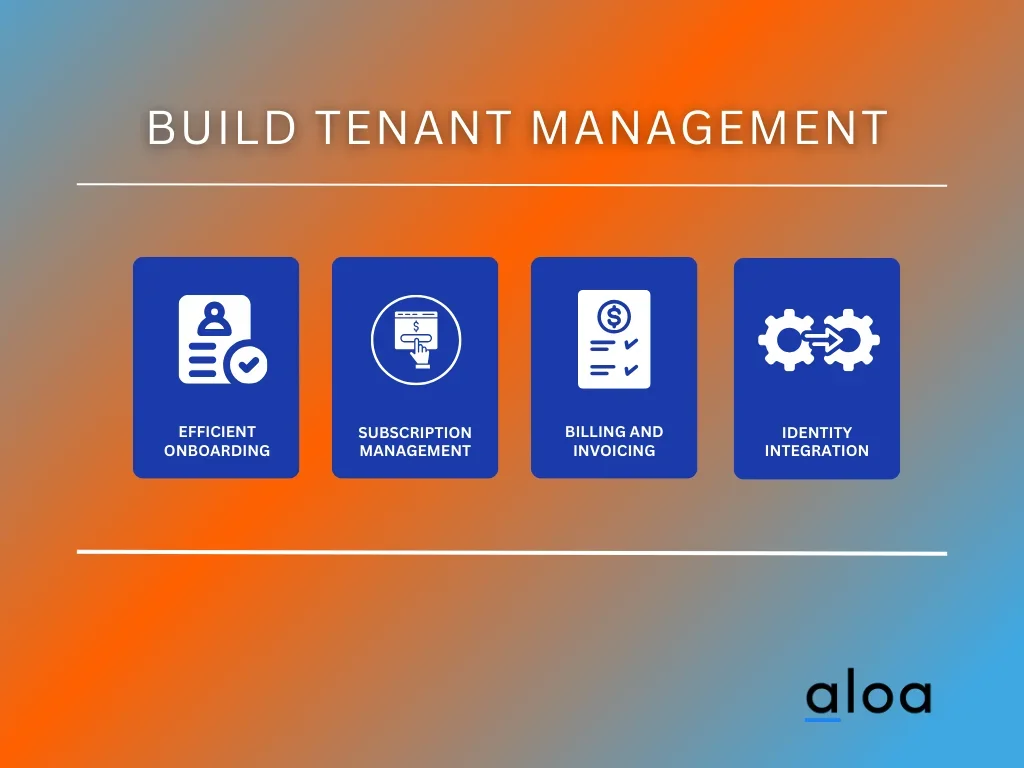
- Efficient Onboarding: Simplify tenant registration and configuration with user-friendly forms and clear instructions.
- Subscription Management: Offer various pricing plans, automate renewals, and allow for easy plan adjustments by integrating subscription management software features.
- Billing and Invoicing: Integrate a precise billing system with multiple payment options, tax compliance, and transparent reporting.
- Identity Integration: Enhance security and user management by incorporating established identity providers for authentication and authorization. This simplifies user access and strengthens overall system security.
By focusing on these considerations within the Tenant Management system, you can create a seamless and efficient experience for your tenants, fostering long-term relationships and enhancing the overall success of your SaaS and multi-tenancy database.
Step 5: Implement Scalability
Scalability is a critical element in constructing a SaaS and multi-tenancy database. As your user base and data volume inevitably increase, scalability becomes essential to maintain system performance. Horizontal scaling involves adding more servers or nodes to your database setup, distributing the workload, and accommodating more tenants. This ensures your system can handle growing traffic and data without compromising responsiveness.
Additionally, consider vertical scaling, which entails upgrading server resources like CPU and RAM to boost performance and capacity immediately. By blending horizontal and vertical scaling, you can create a flexible infrastructure that adapts to your SaaS and multi-tenancy application's evolving demands, guaranteeing a seamless user experience.
Step 6: Ensure Security
Security is a top priority when building a SaaS and multi-tenancy database. Beyond the basics mentioned in the previous response, there are several additional considerations to ensure the highest level of security for your system:
- Encryption: Secure data in transit (SSL/TLS) and at rest to protect against unauthorized access.
- Access Control: Implement robust authentication and authorization with RBAC.
- Data Protection: Use data masking and redaction for sensitive info.
- Audit Trails: Maintain detailed logs for transparency and security tracking.
- Compliance: Adhere to industry regulations like GDPR and HIPAA for data protection and trust-building.
By addressing these additional considerations, you can create a robust security framework that protects your SaaS and multi-tenancy database from common threats and ensures data confidentiality, integrity, and availability, ultimately enhancing tenant trust and satisfaction. Regular security audits and updates should be part of your ongoing maintenance to stay ahead of emerging security challenges.
Step 7: Monitor and Maintain
Monitoring and maintaining are crucial to managing a SaaS and multi-tenancy database. Regularly monitoring the database's performance and health ensures it operates smoothly and efficiently, minimizing downtime and disruptions for your tenants. By implementing automated monitoring and alerting systems, you can promptly identify and address any issues that may arise, reducing the risk of data loss or service interruptions.
In addition to monitoring, planning for regular maintenance tasks such as backups, updates, and database optimization is essential. Backups safeguard tenant data in case of unforeseen disasters, while updates keep the database system secure and up to date. Database optimization helps maintain optimal performance as data grows and usage patterns change.
Standard Features of Multi-tenant SaaS Databases
The demand for SaaS and multi-tenancy databases is rising. These databases offer a shared infrastructure that allows multiple tenants or users to access and manage their data securely. To build a robust SaaS and multi-tenancy database, it's essential to understand the standard features required to meet the diverse needs of both administrators and users.
Let's explore these features in detail, focusing on their role in enhancing data privacy, scalability, and operational management.
Features for Admin
Administrators play a crucial role in managing and maintaining multi-tenant SaaS databases. To effectively fulfill their responsibilities, they need powerful features tailored to their needs.
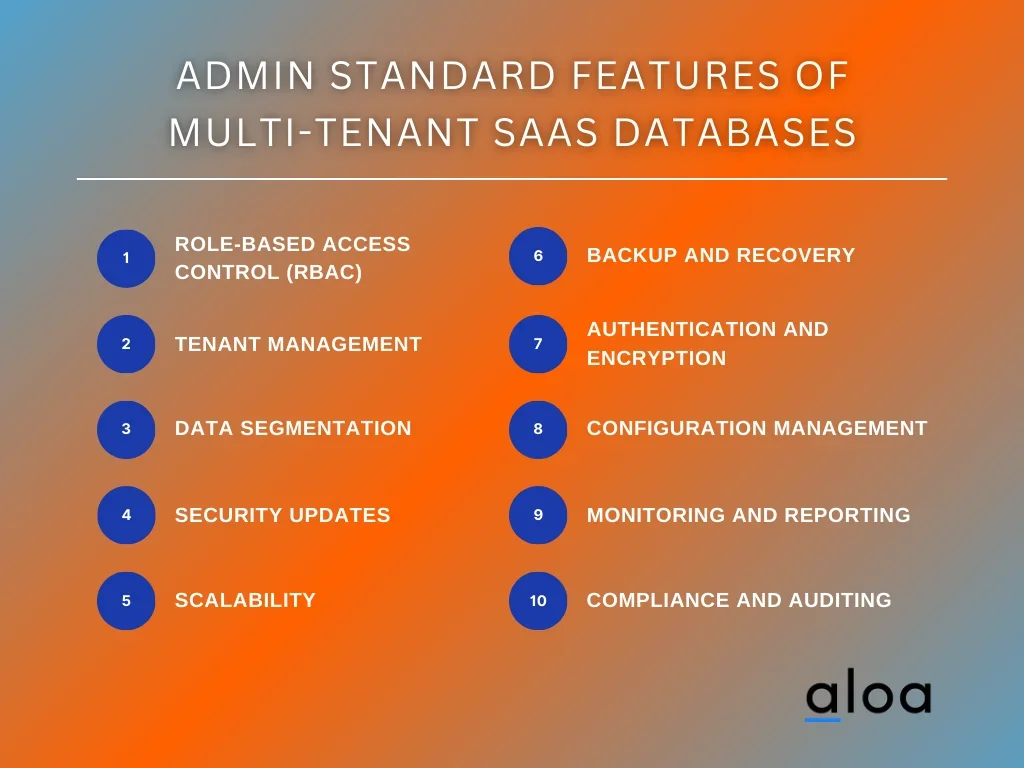
- Role-Based Access Control (RBAC): RBAC allows administrators to define and manage user roles and permissions within the database. This feature ensures that each tenant has the appropriate level of access to data and functionality.
- Tenant Management: Admins should be able to onboard new tenants easily and manage their accounts efficiently. This includes provisioning resources, defining user roles, and monitoring tenant usage.
- Data Segmentation: Multi-tenant databases must provide data segmentation capabilities, allowing admins to segregate tenant data logically. This ensures data privacy and compliance with regulatory requirements.
- Security Updates: Regular security updates are critical to protect tenant data from vulnerabilities. Admins should be able to apply patches and updates seamlessly without disrupting service.
- Scalability: It is essential to scale resources based on the tenants' number and usage patterns. This ensures optimal performance and cost-effectiveness.
- Backup and Recovery: Admins need reliable backup and recovery options to safeguard tenant data from accidental deletions or system failures.
- Authentication and Encryption: Strong authentication mechanisms and data encryption are vital to protect tenant data from unauthorized access and breaches.
- Configuration Management: Admins should be able to customize the database configuration to meet the specific needs of tenants, ensuring flexibility and adaptability.
- Monitoring and Reporting: Comprehensive monitoring tools help administrators track system performance, tenant activity, and potential issues. Detailed reporting capabilities aid in decision-making and optimization.
- Compliance and Auditing: SaaS and multi-tenancy databases often serve industries with strict compliance requirements, such as healthcare and finance. Admins must have auditing features to ensure compliance and provide an audit trail for tenant data access.
Features for User
Conversely, users interact directly with the multi-tenant SaaS database to access and manipulate their data. To provide a seamless user experience, specific features are essential.
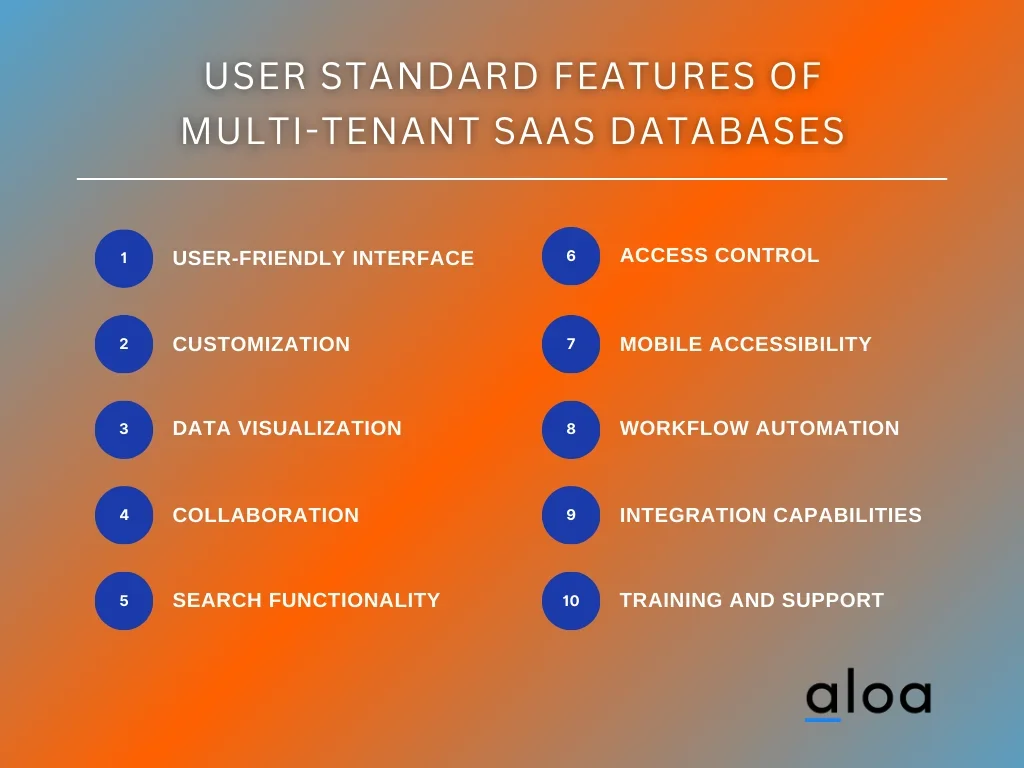
- User-Friendly Interface: A user-friendly interface simplifies data entry, retrieval, and manipulation, making it easier for tenants to utilize the database effectively.
- Customization: Users should be able to customize their dashboards and views according to their preferences and needs.
- Data Visualization: Interactive data visualization tools enable users to gain insights from their data through charts, graphs, and reports.
- Collaboration: Collaboration features such as shared documents and real-time communication enhance user productivity and efficiency.
- Search Functionality: Robust search capabilities enable users to quickly find the information they need within the database.
- Access Control: Users should be able to control who can access their data within the multi-tenant environment, ensuring data privacy.
- Mobile Accessibility: Mobile-friendly access allows users to work independently, increasing flexibility and productivity.
- Workflow Automation: Automation features help users streamline repetitive tasks and processes, saving time and reducing errors.
- Integration Capabilities: Integration with other software applications and services is crucial for users to maximize the utility of their data.
- Training and Support: Adequate training resources and responsive customer support ensure that users can leverage the database effectively and address any issues promptly.
Multi-tenant SaaS vs. Single-tenant SaaS
When providing software solutions to multiple users, choosing between multi-tenant SaaS and single-tenant SaaS is a critical decision that can significantly impact your application's efficiency, scalability, and cost-effectiveness.
Let's explore the distinctions between these approaches by listing five critical factors and explaining each in detail.

Number of Tenants
- Multi-tenant SaaS: In a SaaS and multi-tenancy model, a single instance of the software serves multiple tenants simultaneously. This means that numerous customers share the same application instance and database.
- Single-tenant SaaS: Conversely, single-tenant SaaS dedicates a separate software instance to each tenant. This approach provides isolation and autonomy to individual customers.
Multi-tenant SaaS minimizes resource duplication and can efficiently serve many tenants, making it a cost-effective option for businesses with a high volume of users. In contrast, single-tenant SaaS caters to each customer's specific needs but may involve higher infrastructure and maintenance costs due to the need for dedicated resources.
Maintenance Costs
- Multi-tenant SaaS: Maintenance and updates are applied to the entire system, benefiting all tenants simultaneously. This streamlines the process and ensures that everyone is on the latest version.
- Single-tenant SaaS: Maintenance is performed separately for each software instance in a single-tenant environment. This can lead to increased operational complexity and potentially longer update cycles.
From a maintenance perspective, multi-tenant SaaS offers economies of scale as the SaaS provider can optimize resources and reduce overall costs. On the other hand, single-tenant SaaS allows more control over updates but may result in higher maintenance expenses.
Dedicated Infrastructure
- Multi-tenant SaaS: It relies on shared infrastructure where multiple tenants' data coexists in the same environment.
- Single-tenant SaaS: Each tenant enjoys dedicated infrastructure, ensuring data isolation and enhanced security.
Multi-tenant SaaS leverages shared resources efficiently, but data segregation and security measures are crucial to prevent unauthorized access. Single-tenant SaaS guarantees data isolation but requires additional infrastructure resources.
Security System
- Multi-tenant SaaS: Security measures must be robust to protect all tenants' data within the shared environment. A breach could affect multiple customers.
- Single-tenant SaaS: Security measures can be tailored to meet each tenant's needs, providing a more customized approach.
Multi-tenant SaaS demands a comprehensive security system to protect customer data. In contrast, single-tenant SaaS offers more control over security but may require more significant effort in tailoring security measures.
Scalability
- Multi-tenant SaaS: Scaling resources to accommodate the growing needs of your tenants is generally more straightforward in a multi-tenant environment. Cloud providers like Microsoft Azure and AWS offer features such as elastic pools to facilitate scalability.
- Single-tenant SaaS: Scaling in a single-tenant setup may involve provisioning additional resources or nodes for each tenant, which can be complex and time-consuming.
Multi-tenant SaaS shines in scalability thanks to its shared resources and streamlined infrastructure. Single-tenant SaaS may require careful planning and management when dealing with a growing user base.
Key Takeaway
Building multi-tenant SaaS database projects is crucial in the cloud computing landscape. SaaS and multi-tenancy, where multiple users share a single instance of an application, offer several key advantages. It maximizes resource efficiency, making it cost-effective for SaaS vendors and users. It streamlines the deployment and upgrade process, ensuring seamless updates for all tenants.
However, it's essential to consider specific considerations in this tenancy model. Security and data isolation are critical, as tenants' data must remain protected and segregated. Additionally, while multi-tenancy is advantageous regarding resource utilization, it may only be suitable for some scenarios, particularly those requiring high customization for a single customer.
To harness the benefits and overcome the drawbacks, contact us at [email protected] to explore the world of multi-tenant SaaS.

